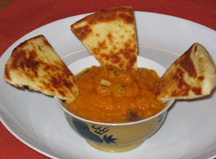My good friend Stephanie’s two-month old baby boy has some fierce gas going on, poor child.
Because Stephanie’s older son has a number of severe food allergies, she is nursing exclusively and herself is on a highly restricted diet: no wheat, dairy, soy, nuts, seafood… and maybe more that I’m forgetting. Yet the baby still has painful gas, otherwise known as colic. She doesn’t know what else she can eliminate from her diet to help him be more comfortable since there’s so little she’s eating already.
Yesterday I learned of a colic remedy from India that I will recommend to her:
Pour one cup of boiling water over a few whole cloves and let steep for 5 minutes. Strain the cloves out and let the water cool to body temp (test on the inside of the wrist). Then, spoon one teaspoon of the cooled liquid into the baby’s mouth. That’s it.
The aryuvedic-trained healer I learned this from swore this remedy would give immediate results and that he had personally witnessed the results many times with his twin nieces (now 3 years old). I’ll let you know when I hear results from Stephanie, and please let me know if you try it with your own baby!

 I had this enormous butternut squash left over from a photo shoot, so I decided to look for something different to do with it. I came across this recipe in Mollie Katzen’s
I had this enormous butternut squash left over from a photo shoot, so I decided to look for something different to do with it. I came across this recipe in Mollie Katzen’s  beyond the first bite, and I had to break down and fix him some mac and cheese instead. My 3-year old daughter, on the other hand, licked her bowl and asked for seconds, though she picked out the mushrooms!
beyond the first bite, and I had to break down and fix him some mac and cheese instead. My 3-year old daughter, on the other hand, licked her bowl and asked for seconds, though she picked out the mushrooms!